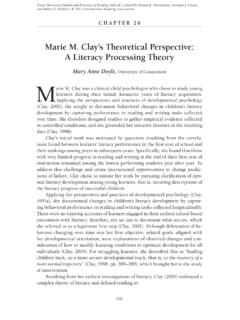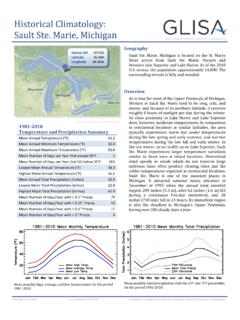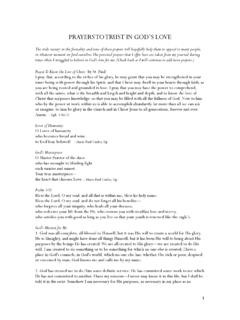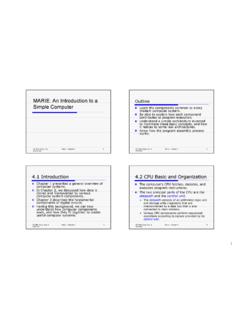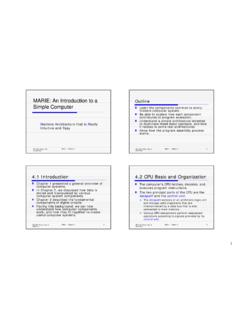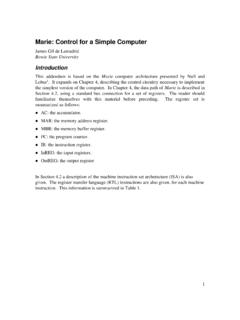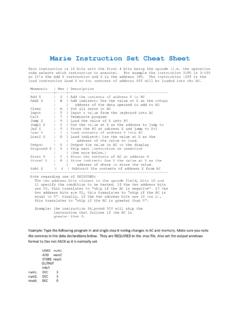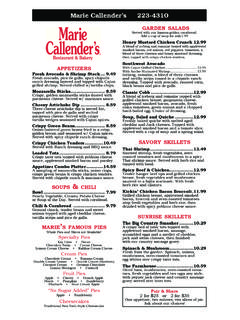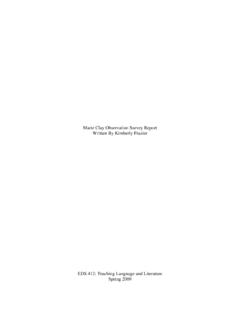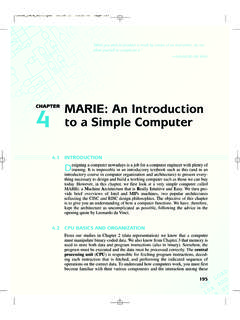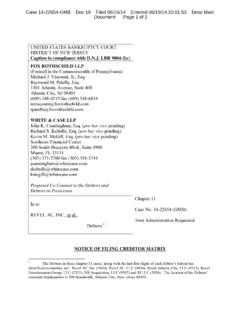Transcription of Marie M. Clay’s Theoretical Perspective: A Literacy ...
1 636 CHAPTER 26 Marie M. Clay s Theoretical perspective : A Literacy processing TheoryMary Anne Doyle, University of ConnecticutMarie M. Clay was a clinical child psychologist who chose to study young learners during their initial, formative years of Literacy acquisition. Applying the perspectives and practices of developmental psychology (Clay, 2001), she sought to document behavioral changes in children s Literacy development by capturing performance in reading and writing tasks collected over time. She therefore designed studies to gather empirical evidence collected in controlled conditions, and she grounded her tentative theories in the resulting data (Clay, 1998).
2 Clay s initial work was motivated by questions resulting from the correla-tions found between learners Literacy performance in the first year of school and their rankings among peers in subsequent years. Specifically, she found that those with very limited progress in reading and writing at the end of their first year of instruction remained among the lowest performing students year after year. To address this challenge and create instructional opportunities to change predic-tions of failure, Clay chose to initiate her work by pursuing clarification of opti-mal Literacy development among young learners, that is, securing descriptions of the Literacy progress of successful the perspectives and practices of developmental psychology (Clay, 1991a), she documented changes in children s Literacy development by captur-ing behavioral performance in reading and writing tasks collected longitudinally.
3 There were no existing accounts of learners engaged in their earliest school-based encounters with Literacy ; therefore, she set out to document what occurs, which she referred to as a legitimate first step (Clay, 2001). Although delineation of be-haviors changing over time was her first objective, related goals, aligned with her developmental orientation, were explanations of observed changes and con-sideration of how to modify learning conditions to optimize development for all individuals (Clay, 2004). For struggling learners, she described this as leading children a more secure developmental track, that is, to the recovery of a more normal trajectory (Clay, 1998, pp.)
4 288 289), which brought her to the study of from her earliest investigations of Literacy , Clay (2001) embraced a complex theory of Literacy and defined reading asMarie M. Clay s Theoretical perspective 637a message-getting, problem-solving activity, which increases in power and flexibil-ity the more it is practised. It is complex because within the directional constraints of written language, verbal and perceptual behaviours are purposefully directed in some integrated way to the problem of extracting sequences of information from texts to yield meaningful and specific communications. (p. 1)Her quest for Theoretical explanations focused on building understandings of both the specific perceptual and cognitive behaviors involved in reading and writing and explanations of the integration of complex in-the-head processes.
5 Thus, explana-tions of progress involved descriptions of working systems, that is, the perceptual and cognitive working systems directed to complete reading and writing acquisition of Literacy processing begins when a child is expected to compose and write a simple message or read a simple continuous text (Clay, 2001, p. 97), for it is in processing complete messages that the working systems for Literacy are engaged and developed. She therefore focused on learners reading continuous texts and composing and writing personal , Clay focused on discovering the emerging and changing Literacy be-haviors of children who were found to be proficient readers and writers for their age cohort.
6 She sought to base her inferences on patterns of development in the behaviors of those children exhibiting expected changes in reading and writing over their first year of school. An additional benefit of detailed accounts of opti-mal development was understandings of when and how to begin teaching, of the changes that may be expected over time, of the track that most children take, of the variability to be expected, and of different developmental paths (Clay, 1998, p. 255).Clay considered the pre-school, developmental histories of children to be unique, individual, and replete with complex learning tasks. Children construct their own understandings as a result of opportunities to learn, they do not shy away from complexity, and they bring their unique stores of knowledge with them to school.
7 At 5 years of age, each school entrant has extensive knowledge of oral language even though their oral language acquisition is incomplete. Their oral lan-guage proficiency, their vocabulary knowledge, their knowledge of their worlds, and their pre-school experiences with Literacy are available when formal Literacy instruction begins and they initiate construction of complex processing following discussion reviews Clay s discoveries resulting from her me-ticulous efforts to describe changes observed in children s Literacy processing during early acquisition, the Theoretical perspective resulting from her quest to explain observed changes.
8 And actions relative to promoting optimal develop-ment for young learners in need of a more secure developmental Efforts: Documenting Changes Observed in Literacy ProcessingClay began her quest to document change in observable Literacy behaviors with an atheoretical, no-hypothesis stance to data collection (Clay, 1982). Unsatisfied 638 Doylewith existing explanations of reading acquisition, she sought new understand-ings through scientific methodology involving both qualitative and quantitative procedures. Her initial goal was to record children s behaviors sequentially using reliable, systematic sampling and observation techniques ( Jones & Smith-Burke, 1999, p.)
9 262).Clay s methodology deviated from prevalent approaches that tended to quan-tify the effects of instruction by examining learners pre- and postinstructional performance. In opposition to quantifying the effects of instruction (or teaching), Clay s interest was the delineation of qualitative changes in children s learning. She focused on the study of observable behaviors in how children work in reading and writing continuous texts ( , Literacy processing ) and interpreted changes as signals of change in psychological processes, such as perceiving, linking, and decision making. She referred to her perspective as a Literacy processing view of progress in Literacy acquisition and determined that the resulting descriptions of change offered an alternative view of progress alternative to the more com-mon use of pre- and posttests and statistical computations to set expectations (of both curricular goals and student achievement) and to evaluate results (Clay, 2001).
10 Her focus included examining what young readers do as they encounter and problem solve increasingly difficult tasks. Therefore, by studying learners over time through the documentation of observed behaviors, she sought to clarify the sequence of changes in ways children process information and the emergence of competencies for effective reading and conduct her research, she developed and applied an unusual lens, defined by her as any observational tool or research methodology that gathers detailed data on changes in Literacy processing over short intervals of time from subjects engaged in reading or writing continuous texts (Clay, 2001, p.)
